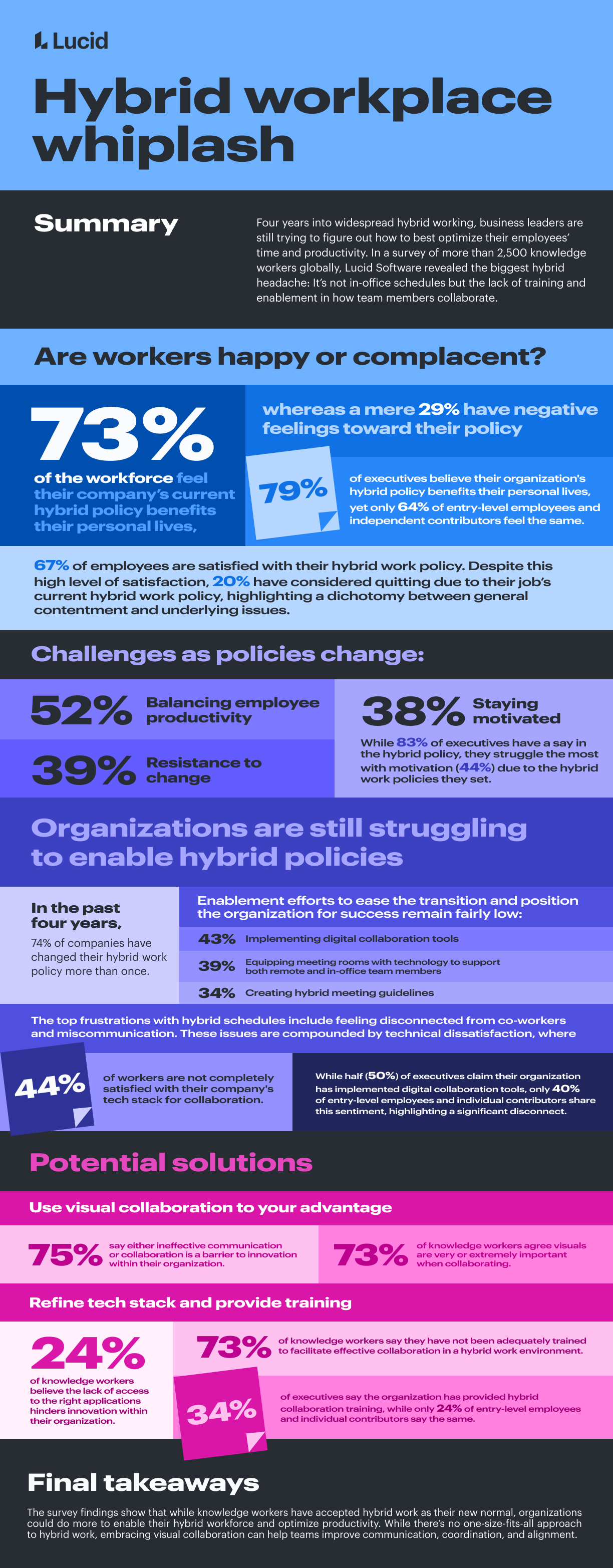
Experiencing hybrid work whiplash? Survey reveals key gaps in enabling hybrid teams
Reading time: about 4 min
Four years into widespread hybrid working, business leaders are still figuring out how to best optimize their employees’ time and productivity. From sending teams back into the office to implementing new employee monitoring programs, organizations are eager to find the most effective approach.
So we had to know: What approaches are working? And what challenges and gaps still exist in the hybrid workplace? To answer these questions, Lucid commissioned a survey of more than 2,500 knowledge workers globally.
The data shows that the greatest problem is not the hybrid policies themselves but rather the lack of collaboration training and enablement within these policies.
Is there a hybrid model that’s better than others?
The simple answer is no. There’s not one policy that outshines others. The majority of survey respondents (67%) were satisfied with their current policy. Here’s the kicker: Those policies vary widely, with 32% in the office two to three days per week, 30% in the office full-time, 14% fully remote (other than large team events), and various others.
However, it has taken a few iterations on the policies for most organizations to get to their current model, with 74% of companies changing their hybrid work policy at least once over the last four years.
Don’t underestimate the impact of policy change on workers. The top challenges reported as policies change were:
-
Balancing productivity, reported by 52% of respondents
-
Resistance to change, reported by 39%
-
Staying motivated, reported by 38%
In other words, given that most workers don’t have an issue with their hybrid policy, further change may do more harm than good as teams recover from hybrid work whiplash.

Change management guide
The more change there is, the more resistance there will be. Learn how to keep employees motivated throughout necessary large-scale transitions.
Get the guideOrganizations are still struggling to enable their hybrid policies
Hybrid policies may vary from organization to organization, but the challenges look similar regardless of policy: inefficient meetings, difficulty sharing information, and alignment issues.
Even for organizations with full-time office policies, there will always be employees who miss context because they are out of the office for vacation, sick time, conflicting meetings, or whatever else life throws their way.
Organizations need an intentional way to help their employees collaborate and align.
However, our survey shows surprisingly low efforts taken to enable hybrid work:
-
Only 43% of respondents say their organization has implemented digital collaboration tools.
-
39% say their org has equipped meeting rooms with technology to support both remote and in-office team members.
-
37% say their company provided hybrid facilitation or collaboration training.
-
34% say their organization created hybrid meeting guidelines.
To complicate matters more, executives believe they are doing more to enable the organization than entry-level employees and individual contributors report. While 50% of C-Suite respondents say the org has implemented digital collaboration tools, only 40% of entry-level employees say the same. We see this trend in a couple of other places: 34% of execs (but only 24% of entry-level employees) say the organization has provided hybrid collaboration training, and 39% of execs (but only 29% of entry-level employees) report the creation of hybrid meeting guidelines.
This perception gap indicates that there is still work to do, both in enabling employees and making employees aware of the tools and resources available to them.

How to set your hybrid organization up for success
75% of workers say either ineffective communication or collaboration hinders innovation within their organization. Put another way: The collaboration struggles affecting hybrid teams are hurting an organization’s ability to stay competitive.
Let’s dive into a few ways organizations can help their hybrid teams collaborate.
-
Adopt a digital-first approach. 41% of respondents who reported project deficiencies believe that their teams lack alignment. By prioritizing digital means to collaborate—for example, taking shared notes on a virtual whiteboard during meetings—teams can create digital artifacts to fuel alignment.
-
Add visual collaboration to your tech stack. 73% of knowledge workers say visuals are very or extremely important when collaborating. With visual collaboration solutions like virtual whiteboards and intelligent diagramming software, you can give hybrid teams a shared space to ideate, plan, prioritize, and work together continuously.
-
Provide collaboration training. Teams need to learn new skills (like asynchronous collaboration) to work together effectively in hybrid environments. But only 73% of workers say they’ve received this training. Close the gap by providing your team with resources and training to intentionally build these modern workplace collaboration skills.
There may not be a single hybrid policy that’s best for your organization, but regardless of policy, there are steps you can—and should—take to enable effective collaboration and ultimately set your organization up for success.

Guide: How to enable hybrid collaboration
Get tips for setting up your office space, building your tech stack, and refining your culture to best support hybrid collaboration.
Learn moreAbout Lucid
Lucid Software is the leader in visual collaboration and work acceleration, helping teams see and build the future by turning ideas into reality. Its products include the Lucid Visual Collaboration Suite (Lucidchart and Lucidspark) and airfocus. The Lucid Visual Collaboration Suite, combined with powerful accelerators for business agility, cloud, and process transformation, empowers organizations to streamline work, foster alignment, and drive business transformation at scale. airfocus, an AI-powered product management and roadmapping platform, extends these capabilities by helping teams prioritize work, define product strategy, and align execution with business goals. The most used work acceleration platform by the Fortune 500, Lucid's solutions are trusted by more than 100 million users across enterprises worldwide, including Google, GE, and NBC Universal. Lucid partners with leaders such as Google, Atlassian, and Microsoft, and has received numerous awards for its products, growth, and workplace culture.
Related articles
Digital collaboration reimagined: A new approach for aligning teams
Whether your teams are in-office, remote, or hybrid, learn why digital-first collaboration is the key to alignment.
[Guide] How to set up your hybrid workplace to maximize collaboration
Every team is a hybrid team. Learn how to set up your hybrid workplace with the right office design and culture to maximize collaboration.
Why a return-to-office policy isn't a silver bullet to business problems
Looking to increase productivity, collaboration, and innovation? Focus on how teams work together—not where.
Lessons learned from remote work that you should bring back to the office
Here are six lessons we’ve learned from remote work that you should bring with you to the office.
